簇内双组分调控因子对vilmorinianum Streptomyces YP1 Granaticin生产的增强作用及其机制
IF 3.9
2区 生物学
Q2 BIOTECHNOLOGY & APPLIED MICROBIOLOGY
引用次数: 0
摘要
Granaticins是一类具有生物活性的苯并异铬equinones (BIQs),是一种具有生物活性的天然蓝色色素,具有抗菌性能和临床抗癌应用前景。然而,它们的临床和工业应用受到低产量和不明确的生物合成调控的限制。在本研究中,我们鉴定了一种罕见的簇内双组分系统(TCS; orf10/orf11),在新型高产菌链霉菌vilmorinianum YP1的granaticin生物合成相关基因簇(BGC)中。orf10编码MerR家族转录调节因子,而orf11编码传感器组氨酸激酶。通过单敲除、双敲除和互补实验确定orf10和orf11的作用。过表达这两个基因的葡萄球菌YP1的granaticins产量增加。值得注意的是,orf10过表达导致granaticin B滴度达到创纪录的716.27mg/L,比本地生产水平有了实质性的提高。利用超高效液相色谱串联质谱(UPLC-MS/MS)分析获得的代谢图谱显示,组合过表达突变体的代谢过程与单一过表达突变体的代谢过程有显著差异。这些发现不仅建立了簇内tcs与花青素生物合成之间的功能联系,而且为克服生产瓶颈提供了有效的工程策略。我们的工作促进了对BIQ调控机制的理解,并强调了S. vilmorinianum YP1是工业规模granaticin生产的一个有前途的平台。本文章由计算机程序翻译,如有差异,请以英文原文为准。
Enhancement and mechanism of in-cluster two-component regulatory factors on granaticin production in Streptomyces vilmorinianum YP1
Granaticins, a class of bioactive benzoisochromanequinones (BIQs), are natural blue pigments with biological activities, including antibacterial properties and promising clinical anticancer applications. However, their clinical and industrial applications are limited by low production yields and unclear biosynthetic regulation. In this study, we identified a rare in-cluster two-component system (TCS; orf10/orf11) within the granaticin biosynthesis-related gene cluster (BGC) of Streptomyces vilmorinianum YP1, a novel high-yielding producer. The orf10 encodes a MerR family transcription regulator, while the orf11 encodes a sensor histidine kinase. The roles of orf10 and orf11 were determined using single and double knockouts and complementation experiments. The yield of granaticins increased with the overexpression of the two genes in S. vilmorinianum YP1. Notably, orf10 overexpression resulted in a record high granaticin B titer of 716.27 mg/L, representing a substantial improvement over native production level. The metabolic map obtained using Ultra Performance Liquid Chromatography Tandem Mass Spectrometry (UPLC-MS/MS) analysis revealed that the metabolic processes of the combined overexpression mutant were significantly different from those of the single overexpression mutants. These findings not only establish the functional link between the in-cluster TCSs, and granaticin biosynthesis but also provide an effective engineering strategy to overcome production bottlenecks. Our work advances the mechanistic understanding of BIQ regulation and highlights S. vilmorinianum YP1 as a promising platform for industrial-scale granaticin production.
求助全文
通过发布文献求助,成功后即可免费获取论文全文。
去求助
来源期刊

Journal of biotechnology
工程技术-生物工程与应用微生物
CiteScore
8.90
自引率
2.40%
发文量
190
审稿时长
45 days
期刊介绍:
The Journal of Biotechnology has an open access mirror journal, the Journal of Biotechnology: X, sharing the same aims and scope, editorial team, submission system and rigorous peer review.
The Journal provides a medium for the rapid publication of both full-length articles and short communications on novel and innovative aspects of biotechnology. The Journal will accept papers ranging from genetic or molecular biological positions to those covering biochemical, chemical or bioprocess engineering aspects as well as computer application of new software concepts, provided that in each case the material is directly relevant to biotechnological systems. Papers presenting information of a multidisciplinary nature that would not be suitable for publication in a journal devoted to a single discipline, are particularly welcome.
 求助内容:
求助内容: 应助结果提醒方式:
应助结果提醒方式:


